Amid a global rush for critical minerals, India is looking to develop its lithium supply chain through various means, including leveraging private and public industries to sustain its future sectoral growth and to fix strategic vulnerabilities. Much of this will be pushed by technology adoption and the transition to green energy, with lithium potentially making a critical contribution to India’s economic growth and national security.
In 2023 the Ministry of Mines released a ‘Critical Minerals for India’ list. The document defines critical minerals as those which ‘are essential for economic development and national security’ and whose ‘lack of availability’ or ‘concentration of extraction or processing in a few geographical locations’ may lead to the disruption of supply chains.
Lithium is categorised as a ‘strategic’ mineral with 100 per cent import dependence, placing it at the top of the priority list. Rising imports indicate that the challenge has become acute — Li-ion battery imports increased from US$384.6 million in 2018–19 to US$2.8 billion in 2022–23. With China making up 60–70 per cent of lithium refining capacity and a significant portion of lithium reserves, this increase helps explain the China factor emerging in Indian policymaking and is reflected in the pace of new critical minerals policies.
Recent discoveries of new lithium reserves in Jharkhand, Rajasthan and Jammu and Kashmir in 2023 have attracted attention from government and private players. To leverage the deposits, the government has eased the mining process by allowing the auction of lithium mines. The decision opened the gates for private players to mine lithium, a shift from the mostly state-run companies previously engaged in the process. In 2023, 20 blocks of critical and strategic minerals were auctioned to boost the mining process, including two lithium blocks in Jammu and Kashmir and Chhattisgarh. India is also looking to auction fifteen off-shore blocks for mineral mining in March 2024.
The government has also begun liberalising policies and regulations in the mining sector to encourage industries to manufacture in India. These steps, which aim to mitigate bureaucratic obstructions in those areas, signal that India is serious about establishing a secure supply chain. This change in policy environment aims to addresses supply chain vulnerabilities and dependence on competitors for strategic minerals supply.
In addition to enacting laws and policies, the government has also focused on extending incentives, simplifying regulations, pushing reforms and fixing loopholes in order to build a lithium critical mineral supply chain. The government recently announced an incentive of 25 per cent of approved project costs for public and private companies to support the exploration of minerals, and is also considering banning the export of four critical minerals, including lithium.
New Delhi is aiming to build an electric vehicle sector ecosystem, and lithium is an essential component for this. Within the industry, battery technology is considered vital for India’s economic growth, green energy transition and the accomplishment of its goal of net zero emissions by 2070. Demand for batteries is expected to rise to 260 GWh by 2030. To address this, India has extended a Rs 18,000 crore (US$2.16 billion) Production Linked Incentive (PLI) scheme to develop Advanced Chemistry Cells. This decision has attracted many domestic private players like Ola Electric and Reliance New Energy. The second PLI tranche is expected to entice global heavyweights such as Panasonic, LG Chem and Samsung.
To encourage research and innovation, India has also extended assistance through funds and technology transfers to develop indigenous lithium battery capabilities. The government has transferred cost-effective Li-ion battery recycling technology to startups and recycling industries under ‘Mission LiFE’. Focusing on research and innovation, the Department of Science and Technology is also supporting 32 projects for battery storage.
But India still faces many obstacles, including the absence of a trusted supply chain network both upstream and downstream. New Delhi’s dependency on China for raw materials and sectoral end products in the form of lithium and lithium-ion batteries, remains challenging. India imports almost 70–80 per cent of its lithium and 70 per cent of its lithium-ion from China. This reliance on China could put India’s growth and domestic industries at risk if tensions between the countries continue.
The government is also developing new international partnerships to enhance its lithium mineral security and de-risk the lithium supply chain. India has finalised lithium agreements with Argentina to secure five blocks of the mineral and has already signed two with Australia. India is also discussing developing processing technology with United States on critical minerals. Domestically, progress in mineral security has been positive but further efforts are required to remove bureaucratic red tape and domestic innovation restraints.
Going forward, the government should incentivise the private mining sector and startups interested in lithium exploration and build the supply chain across the upstream, midstream and downstream arenas. India must also partner with like-minded countries such as the United States, Japan, Australia, Indonesia and South Korea to strengthen global lithium supply chain management and reduce strategic vulnerabilities. Leveraging forums such as the Indo-Pacific Economic Framework, Mineral Security Partnership and the Quad must be prioritised to connect initiatives in the Indo-Pacific region and later extend them globally.
Abhishek Sharma is Research Associate at the Centre for Air Power Studies and a PhD Candidate at the Department of East Asian Studies in the Delhi University.

